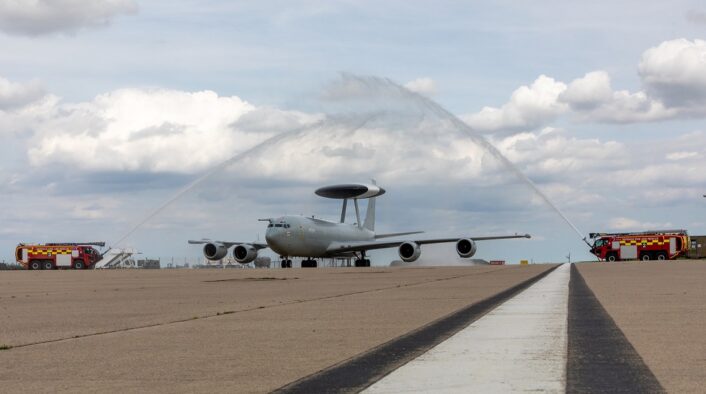The RAF Sentry fleet will retire later this year after 30 years of service, freeing resources for the E-7A Wedgetail which is set to enter service in 2023.
A Royal Air Force E-3D Sentry AEW1, with serial ZH101 and assigned to No. 8 Squadron, returned to RAF Waddington on Aug. 4, 2021, following the type’s last operational mission, ahead of the retirement later this year. The last mission was flown on July 30 out of RAF Akrotiri (Cyprus), supporting the counter-Daesh Operation Shader, the United Kingdom’s contribution to the fight against ISIS militants in Iraq and Syria.
The Commander of the Intelligence, Surveillance, Targeting and Reconnaissance (ISTAR) Force, Air Commodore Hay, said: “Sentry’s return from a hugely successful overseas deployment heralds a fitting end to over 30 years of continuous service in support of NATO, other coalition and national operations. Whether operating from their home base at Waddington or airfields from across Europe and the broader Middle East, Sentry has contributed by providing a Recognised Air and Maritime Picture that has enabled others to operate with significant freedom of action against the most hostile of threats.”
The RAF E-3D Sentry is returning to @RAFWaddington this afternoon from 903 Expeditionary Air Wing. On 30 July 2021, the aircraft flew its final operational mission.
During the deployment, the aircraft supported @HMSQNLZ #CSG21, Op Shader and @NATO assurance missions. pic.twitter.com/DL7594tvJm
— Royal Air Force (@RoyalAirForce) August 4, 2021
The E-3D Sentry AWACS (Airborne Warning and Control System) first entered service with the RAF in March 1991 and took part in every major British operation including Iraq, Afghanistan, Libya, the broader Middle East and the Caribbean. Since 2015 the aircraft was continuously deployed to RAF Akrotiri to support Operation Shader and, during this final deployment, the Sentry also supported Operation Fortis, the maiden deployment of HMS Queen Elizabeth and the Carrier Strike Group.
Officer Commanding 8 Squadron, Wing Commander Victoria Williams, shared some details about the final deployment: “The deployment of the Sentry fleet to RAF Akrotiri in support of the maiden operational deployment of the Queen Elizabeth Aircraft Carrier and operations in the Middle-East has been a resounding success. This was the first operational detachment of the fleet since 2016 and involved a Whole Force of RAF, Reservists and contractors to deliver 30 missions in 9 weeks. The Sentry was able to provide the recognised air and surface picture to the Carrier Strike Group to facilitate its safe transit from the Straits of Gibraltar to the Suez.”

Another RAF Sentry, ZH103, was also deployed to RAF Akrotiri and returned to the UK a few days before ZH101. The aircraft will formally be retired from service later this year, however its replacement will be ready only in 2023. The RAF is in fact scheduled to receive three brand-new E-7A Wedgetails that will operate from RAF Lossiemouth in Scotland, together with the P-8A Poseidons. The RAF said that, during this capability gap, the ISTAR requirements will be covered by a combination of other aircraft and NATO E-3s.
The RAF initially had five E-7s on order that should have been delivered from 2023 to 2026, but the number has been reduced, following the Defence Review, to just three aircraft. Interestingly, two of the aircraft are said to be second-hand overhauled aircraft that will be converted to the E-7 configuration. The RAF decided to adopt the same Wedgetail designation like the RAAF, specifically E-7 Wedgetail AEW Mk1.
An E-3D Sentry has returned to its home base at @RAFWaddington following its final mission on Operation Shader, bringing to a close 30 years of operational service.
Read more: https://t.co/FmnSRfxrId pic.twitter.com/Z5SmCkl91S
— Royal Air Force (@RoyalAirForce) August 5, 2021
The early retirement of the Sentry has been met by controversies, as Mark Francois, Member of Parliament and former Minister of State for the Armed Forces, was quoted saying: “It is unacceptable the RAF will lose its own eye in the sky for two years. We should not be playing games with the air defence of the United Kingdom under any circumstances.”
A Sentry pilot with over 4,000 flight hours on the aircraft, former Squadron Leader Ian Green, admitted that, while this early retirement might be sad, it might probably be a forced choice: “It was upgraded throughout its life but… it’s got to a point now that without drastic action and very expensive upgrades the E-3 has just run out of computing power”. A similar situation was faced by the Sentinel R1, which was retired earlier this year due to “increasing obsolescence” after important upgrades were cancelled by the 2010 Defence Review.
However, this will not be the end for all the British E-3Ds, as one has been purchased by the U.S. Airborne Strategic Command, Control, and Communications Program Office for 15M USD. The aircraft, ZH104, was already stored at Northrop Grumman’s Lake Charles Maintenance and Modification Center (Lake Charles Airport, Louisiana), where it will be converted in an E-6B Mercury pilot training aircraft. The aircraft will help reduce an estimated 600 flight hours and 2,400 landings/cycles per year from the E-6 mission aircraft, according to NAVAIR.









